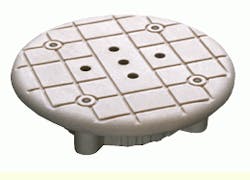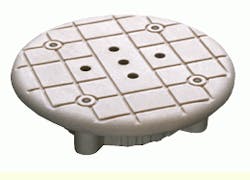Manufacturers take incremental steps to diminish the time and effort necessary to polish fiber-optic connectors.
Patrick McLaughlin
Despite the recent blitz of fiber-optic connectors that require no polishing, installers who intend to run fiber-to-the-desk must learn the proper way to polish a fiber-optic connector. Prepolished connectors do not yet dominate the market, and major fiber-optic connector manufacturers have no plans to stop production of connectors that require polishing.
With polishing being a fact of life for fiber-optic cabling installers, what`s being done to make the polishing process easier and increasingly more efficient? "The development can be compared to baby steps," says Larry Sellers, a senior technical service engineer for 3M Telecom Systems Div. (Austin, TX), who manages the company`s fiber-optic training center. "The purpose for polishing is straightforward: to eliminate, to the extent possible, the glass stub and whatever adhesive you used to secure the fiber in the connector, so that the fiber is flat at the end of the ferrule."
Workmanship techniques
The procedure has not changed much since the dawn of the fiber-optic era, according to Sellers. "Today, some connector types still require three polishing steps, in which the installer begins with coarse polishing paper and moves to increasingly finer paper. Other connectors require only two steps. Wet/dry polishing is still done also, in which the water is used to carry particles away from the surface you`re polishing. Using water allows for a fine polish."
Sellers emphasizes that even though the process can involve several steps, installers have to take care from its beginning to end. "Only the final few seconds of the polishing process affect the connector`s performance," he says. That`s why more than one grade of polishing paper is used; the coarser paper takes away larger particles more quickly, and the finer paper helps ensure the connector meets necessary attenuation and other performance characteristics. To that end, overpolishing is possible and can be a source of performance degradation, particularly with singlemode fiber. Overpolishing a connector leaves an air gap between the fiber and its mate, which allows light reflection. "Some experienced installers, when polishing multimode fiber, can feel when the adhesive is gone," Sellers says. "But when polishing singlemode fiber, it`s best to monitor progress with some type of view scope."
Positive-contact ferrules
Early-generation fiber-optic connectors included ferrules with flat ends and consequently were prone to misalignments in coupling. This misalignment caused separation between the fiber and its mate, resulting in reflection and high loss. The fiber- optics industry responded by producing positive contact (PC) ferrules, which are rounded at their ends.
3M`s Sellers cautions installers that when they are using lapping film with a flat-finish connector, the film should be placed on glass or some other hard surface. When polishing connectors with PC ferrules, he says, use rubber pads beneath the film because the rubber pads accommodate the ferrule`s rounded end. If you use glass with a PC connector, you`ll end up polishing the fiber but not the ferrule around it. Likewise, if you use a rubber pad with a flat-finish connector, you`ll polish away the adhesive around the ferrule, but not the fiber.
Puck evolution
An essential element in the polishing process is the puck, which is sometimes called a disk or jig. The puck holds the connector square to the polishing surface. However, it is not absolutely flat and typically has grooves that allow water to escape during wet polishing. Originally, most pucks were made out of metal, but today, most are made from polymer materials. The move to polymers has largely benefited manufacturers, who can now make polymer-based pucks less expensively than they could make metal pucks.
Polymer-based pucks also can positively affect connector performance, says John Kalusa, marketing manager for fiber-optic products with Methode Electronics Inc. (Chicago, IL). "Contamination, though rare, does happen during polishing," he says. "If the installer is using a metal puck and contamination does occur, the contamination can cause damage to the ferrule, ultimately affecting connector performance. It is visibly undetectable without significant magnification, and typically the connector works when initially installed. So the problem is not recognized right away. But over a long period of time, the connector can exhibit unusually high attenuation. So a connection that seems to work fine at first can eventually fail."
And it`s not logical for a technician to immediately conclude that the problem lies with the polishing puck used during installation. In fact, when the issue is eventually traced to the connector, the most likely remedy is to cut the connector off and install a new one--using the same puck that caused the problem to begin with.
"Another reason for the development of a polymer disk was the tendency for ferrules to become stuck in the ferrule holes of metal pucks and ultimately break," Kalusa adds.
Methode developed the Universal Polishing Disk, which has been available since early 1997. The company offers this disk as a technological enhancement on two fronts. First, as its name implies, the disk accommodates more than one connector type. "Some disk manufacturers offer separate SC, ST, and FC versions," Kalusa says. "Some disks will accommodate more than one connector type, but not all types." The Universal Disk can be used with the three aforementioned types, as well as for fddi and Escon connectors. Kalusa says that Methode also is developing versions of the disk for newly introduced connector styles.
The second attribute that distinguishes Methode`s disk from others is that it polishes four connectors at once. Kalusa points out that placement of glass silica bearings in each of the four "corners" of the round disk helps provide uniformity in terms of polish. "That significant engineering breakthrough allows installers to use the Universal Polishing Disk the same way they use others. No special handling is required to make sure each of the four connectors is appropriately and accurately polished."
The Universal Disk is larger than most others, which Kalusa says is not a detriment. "Many find it easier to grip than a smaller disk," he says.
Automated polishers
In the past few years, automation has made its way into fiber-optic polishing. A handful of manufacturers, including 3M and The Siemon Co. (Watertown, CT), offers polishing machines, which offer consistent finishes and time savings. Because a machine represents a monetary investment that pays off over time, installers of large fiber-optic projects are more likely to invest in one than is an installer of smaller jobs or an installer who infrequently works with fiber.
"Most of the cabling installations I do are with copper wiring; very little is fiber-optic," says Joseph Smith, an independent cabling installer from Manassas, VA. "It would take a long time for an investment in a polishing machine to pay off for me," he adds.
"The size of a job or the amount of fiber work an installer will handle is usually the single largest determining factor in the decision to use or not use an automated polisher," says 3M`s Sellers.
Different machines offer different attributes. Some polish a single connector and others polish more than one. 3M`s, which Sellers helped design, is marketed as a rugged piece of equipment, while The Siemon Co. says its polisher is attractive because it is lightweight and compact but comes in a rugged case. The Siemon Co. also emphasizes speed, saying its machine can polish two connectors simultaneously in less than 15 seconds.
Generally, machines with the capability to simultaneously polish as many as 6, 12, or 18 fibers are designed not for field use but for factory applications.
The four glass silica bearings within Methode Electronics`s Universal Polishing Disk ensure that when a user polishes four connectors at once, all four polishes will be uniform. The polymer-based disk has grooves, as do most polishing disks, to allow water to escape during wet polishing.

